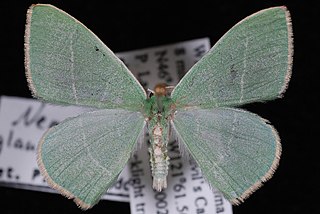
Voria is a genus of flies in the family Tachinidae.

Mesothea is a monotypic moth genus in the family Geometridae described by Warren in 1901. Its only species, Mesothea incertata, the day emerald or plain emerald, was first described by Walker in 1863. It is found in North America.
Nemoria rubrifrontaria, the red-fronted emerald, is a species of moth in the family Geometridae, in the superfamily Geometroidea. The species was described by Alpheus Spring Packard in 1873. It is found in North America.
Hydriomena exculpata is a species of moth in the family Geometridae first described by William Barnes and James Halliday McDunnough in 1917. It is found in North America.

Nemoria festaria is a species of emerald moth in the family Geometridae. It is found in North America.

Synchlora frondaria, the southern emerald, is a species of emerald moth in the family Geometridae. It is found in the Caribbean, Central America, North America, and South America.

Nemoria darwiniata, the Columbian emerald, is a species of emerald moth in the family Geometridae. It was first described by Harrison Gray Dyar Jr. in 1904 and it is found in North America.
Clostera apicalis, the apical prominent or red-marked tentmaker, is a species of moth in the family Notodontidae. It was first described by Francis Walker in 1855 and it is found in North America.

Nemoria glaucomarginaria is a species of emerald moth in the family Geometridae first described by William Barnes and James Halliday McDunnough in 1917. It is found in North America.

Nemoria pulcherrima is a species of emerald moth in the family Geometridae first described by William Barnes and James Halliday McDunnough in 1916. It is found in North America.
Booneacris glacialis, the wingless mountain grasshopper, is a species of spur-throated grasshopper in the family Acrididae. It is found in North America.

Hydriomena marinata is a species of moth in the family Geometridae first described by William Barnes and James Halliday McDunnough in 1917. It is found in North America.

Melanoplus punctulatus, known generally as the pine tree spur-throat grasshopper or grizzly spur-throat grasshopper, is a species of spur-throated grasshopper in the family Acrididae. It is found in North America.
Euphilotes bernardino, the Bernardino blue, is a butterfly in the family Lycaenidae. The species was first described by William Barnes and James Halliday McDunnough in 1916. It is found in North America.

Apodemia mejicanus, the Mexican metalmark or Sonoran metalmark, is a species of butterfly in the family Riodinidae. It was first described by Hans Hermann Behr in 1865. It is found in North America.

Historis odius, the orion cecropian, is a species of crescents, checkerspots, anglewings, etc. in the butterfly family Nymphalidae. It is found in North America.
Digrammia cinereola is a species of moth in the family Geometridae first described by George Duryea Hulst in 1896. It is found in North America.
Euphilotes spaldingi, or Spalding's blue, is a butterfly of the family Lycaenidae. The species was first described by William Barnes and James Halliday McDunnough in 1917. It is found in North America.
Aethalura intertexta, the four-barred gray or smoky carpet moth, is a moth in the family Geometridae. The species was first described by Francis Walker in 1860. It is found in North America.

Tallula is a genus of pyralid moths in the family Pyralidae. There are about 11 described species in Tallula.















